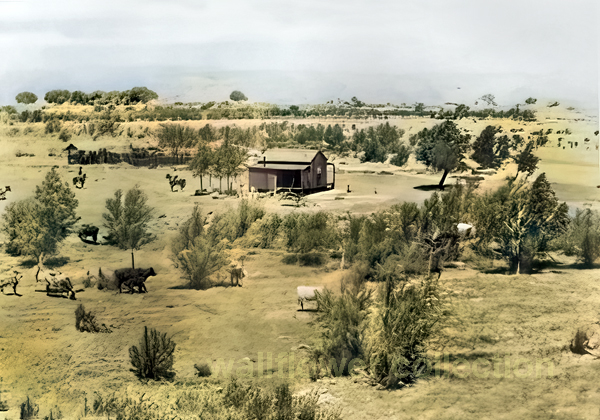WATERMAN, CALICO, BISMARCK
Adapted from GHOST TOWNS of the Upper Mojave DesertSan Bernardino County
by Alan Hensher and Larry M. Vredenburgh - (c)1986
Oro Grande and Waterman

Waterman ranch - base image courtesy Orange County Archives
CALICO WAS A SILVER DEPOSIT waiting to be discovered. Fair roads led from San Bernardino across the Mojave Desert--toward Nevada, Utah, and Arizona. Ranches and supply stations dotted these roads like the motels and service stations of a later era. Nearly everyone, it seemed, prospected on the side, from sheriffs to surgeons. By the late 1870's, much of the desert was staked out in mining claims.
Two areas in particular lured prospectors into the desert: Oro Grande, on the Mojave River, about 45 miles north of San Bernardino, and the Grapevine district, near the later site of Barstow. Oro Grande was the result of rediscoveries of silver and gold ore in mid1880. A mining district was organized, a townsite laid out, and a post office named Halleck established, in January, 1881. Oro Grande presented “a very picturesque appearance” to a visitor in April. “. . . One driving into town at dusk will see the miners returning from work, while the camp fires are burning and supper is being prepared . . . .” A general store, two butcher shops, a hotel, a lodging house, several small homes, a company office and assay office, and a 10-stamp, water powered mill looming in the background “combine to give the town the appearance of a busy mining camp.” (Several Milwaukee capitalists, who would figure prominently at Calico, bought the mines and mill in late 1881 and formed the Oro Grande Mining Company. Though mining quickly faded, Oro Grande survived as an important farming, railroad, and milling center. The post office was renamed Oro Grande in 1925.)
MORE IMMEDIATE was the revival of the George G. Lee claims in the Grapevine district. Lee had found what he thought was mercury ore four miles north of what is now Barstow but died in 1879. Robert W. Waterman, a leading farmer in the San Bernardino Valley (and a future governor) and geologist John L. Porter visited the Lee property in mid-1880. In December, they found silver in samples taken from the claims, staked the area out for themselves, and planned a milling camp on a hill overlooking the Mojave River.
Operations began almost at once. “Doc” George Yager, one of the discoverers of the Silver King Mine at Calico, saw sacks of ore worth up to $3,000 a ton in silver awaiting shipment to San Francisco. During the spring and summer, Waterman and Porter bought machinery for a mill and cleared a millsite with 15 Indians. The ore, meanwhile, was hauled out by wagon for eventual milling in San Francisco. The settlement that was built included a general store run by E.J. Miller and a general store, hotel, and 10-stamp mill operated by Waterman and Porter. Waterman post office was established in October, 1881, though the material for the office and the postmaster's commission (for son Waldo) failed to arrive until November, when the mill started up. The mill was soon running day and night, processing 18 tons of ore a day.
Waterman and Porter made “no loud cry about their success,” giving scant details about their operations. But the heavy bars of silver passing through the express office in San Bernardino made quite a stir. A large crew was working 'at the mine (January, 1882) on ore that assayed up to $1,100 a ton. In less than a year, the Waterman had become the leading silver mine in San Bernardino County. The discoveries at Calico, less than 10 miles away, soon eclipsed news from the Waterman. Perhaps stimulated by the arrival of a second railroad in 1885, a school was built at the milling camp, in front of the mill. This became the nucleus of the Barstow school district. The mine produced $1,611,429 from May, 1881, to mid-March, 1887. At the mill, the post office closed a few weeks later, in April. The buildings at the camp remained standing for several years.